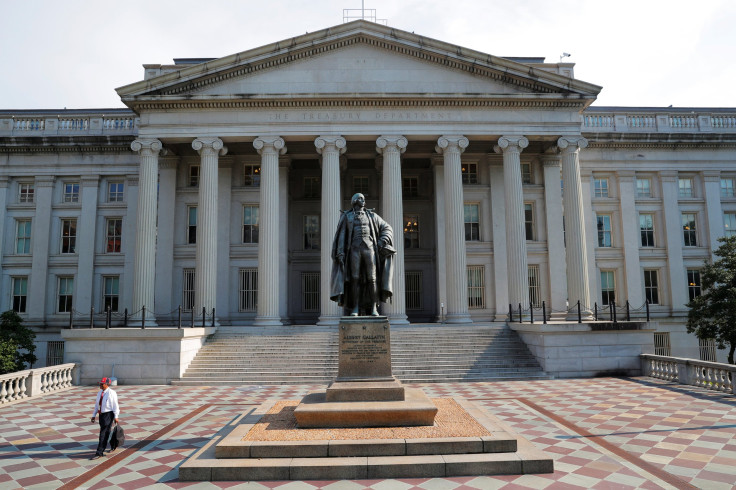No Need For Alarm Over US 2-10’s Yield Curve Inversion, Say Analysts

The flattening U.S. Treasury yield curve, traditionally believed to signal an oncoming recession, is no cause for alarm as the country’s economy continues to be strong, analysts say.
The analysts who spoke to International Business Times also said the 2-10’s yield curve spread is not a reliable indicator of a recession. They note that it would be incorrect to use a single measure to draw conclusions on the prospects of the economy.
The spread between the U.S. 10-year bonds and 2-year notes have narrowed the most since August 2007, sparking concerns among investors. The spread between the U.S. 10-year government bonds and 2-year notes was 26 basis points Monday. Financial markets look at a negative or an inverted 2-10’s yield curve as a precursor to a recession, although there is no clear established timeframe on when a recession can follow such an inversion.
In a note seen by IBT, Wells Fargo said the lead time from each inversion to a recession has, historically, ranged from 8 to 23 months. The bank said it sees zero risk of a recession in the next 6-9 months.
“I don't think there’s a magical connection between the 2-10’s spread and a recession beyond the fact that it’s an indicator of the Federal Reserve’s monetary policy,” says William Dickens, chair of the department of economics at Northeastern University.
Hugh Johnson, chief investment officer at Hugh Johnson Advisors, says: “First in part, the Fed is raising short-term interest rates and secondly, they’ve kept a lid on long-term rates -- in other words, the Fed effectively created the flatter curve itself.”
“It is important to acknowledge that the combination of tightening the short-end, putting some upward pressure on longer-term interest rates, increasing the edge of dollar-denominated securities, and attracting capital to the longer-end is working well,” he adds. “Attracting international capital flows to the longer end has certainly helped as international investors ‘step in’ while the Fed (as part of reducing the size of its balance sheet) ‘steps out.’ It effectively has to some extent kept a lid on the rise in longer rates and kept the curve somewhat flat.”
“So far, this is working very well and suggests quite strongly that the Fed should not back away from its gradual shift toward restraint and should not do so because of concerns about the curve,” Johnson says.
Northeastern University’s Dickens says there is no reason to be alarmed by the 2-10’s yield spread alone, when there is no evidence of weakening in the economy. “I don’t think that the Fed would push the policy so hard if they start seeing weakness in the economy.
The Federal Reserve, in its August meeting, noted that the Federal Open Market Committee expects further gradual increases in the target range for the federal funds rate to be consistent with sustained expansion of economic activity, strong labor market conditions, and inflation near the Committee's symmetric 2 percent objective over the medium term.
In a recent poll conducted by IBT, analysts expect the U.S. Federal Reserve to raise interest rates by 25 basis points to 2.0-2.25 percent at its September 25-26 meeting.

AN UNRELIABLE INDICATOR
Analysts think that historically the inversion of the 2-10’s yield spread has been only “somewhat” useful to predict a recession, including the 1978-1980 or 1980-1982 inversions. They point out that a negative 2-10’s yield spread has proved to be less useful or even unreliable in some other cases, including the 1989, 2000 inversions.
Of the 2-10’s inverted yield curve in 2006-2007, Johnson says the curve inverted well before the start of a recession and then returned to normal positive slope even before the recession of 2008, leaving analysts and strategists puzzled.
Dan Hamilton, director of economics at CLU Center for Economic Research & Forecasting, thinks the yield curve is not a useful indicator to predict a recession. “In our view, the yield curve doesn’t look likely to indicate a recession. It was a useful indicator before and even before, it was imperfect.”
Johnson thinks that the 10 year - 91 day bills spread is a better measure to predict an oncoming recession, and an even better and reliable measure is the 10 year - Fed funds rate spread. “It is not at all coincidental that the 10 year - Federal funds rate spread is a component of the index of leading economic indicators. It qualifies because it is significantly more reliable than other measures of the yield curve,” he says.
Johnson said that the Federal Reserve Bank of New York has done meaningful work on the 10 year - 91 day spread and even quantifies the probability of a recession beginning in 12 months, i.e., in August 2019, based upon the magnitude of the spread. “It is interesting that the probability has indeed increased from 4.06 percent in January to 14.61 percent in August. This is an increase but it is not, comparatively speaking, high. The probability of a recession in 12 months based upon this approach reached 40.73 percent in November 2007.”
© Copyright IBTimes 2024. All rights reserved.




















